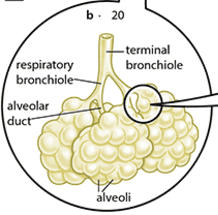AS Level Biology 9700
9. Gas exchange
Written by: Pranav I
Formatted by: Pranav I
Formatted by: Pranav I
9.1 Gas exchange
-
Adapted to:
- Vascular system: A system of fluid-filled tubes, vessels or spaces used for long-distance transport in plants
- Contains xylem and phloem tissues
- Transported fluid is called sap
- Xylem transports water and inorganic mineral ions in xylem vessels → only one direction
- Gas exchange surface: Any part of an organism that allows the movement of gases between the surroundings and the body (large SA : V ratios → body surface; small SA : V ratios → specialised gas exchange surfaces)
- Gas exchange surface of humans → alveoli in the lungs
-
Adapted to:
- Vascular system: A system of fluid-filled tubes, vessels or spaces used for long-distance transport in plants
- Contains xylem and phloem tissues
- Transported fluid is called sap
- Xylem transports water and inorganic mineral ions in xylem vessels → only one direction
- Gas exchange surface: Any part of an organism that allows the movement of gases between the surroundings and the body (large SA : V ratios → body surface; small SA : V ratios → specialised gas exchange surfaces)
- Gas exchange surface of humans → alveoli in the lungs
9.2 Lungs
-
In the thoracic cavity surrounded by the pleural membranes (enclose an airtight space)
- Contain a small quantity of fluid to allow friction free movement
- Air passes through the trachea and bronchi to supply many branching bronchioles which terminate in alveoli where gas exchange occurs between alveolar air and blood in pulmonary capillaries
-
In the thoracic cavity surrounded by the pleural membranes (enclose an airtight space)
- Contain a small quantity of fluid to allow friction free movement
- Air passes through the trachea and bronchi to supply many branching bronchioles which terminate in alveoli where gas exchange occurs between alveolar air and blood in pulmonary capillaries

9.3 Trachea, bronchi and bronchioles
- Trachea: the tube-like structure that extends from the larynx to the bronchi; it allows movement of air into and out of the lungs (1)
-
Bronchus: a major branch of the trachea that extends into the lungs (2)
- Each subdivides and branches extensively to form a bronchial tree in each lung
- Bronchiole: A microscopic branch of a bronchus that leads to the alveoli
- Terminal bronchioles divide to form even narrower respiratory bronchioles that supply the alveolar ducts with air

-
Cartilage in the trachea and bronchi
- Keeps these airways open and air resistance low
- Prevents them from collapsing or bursting as the air pressure changes during breathing
- Regular arrangement of C-shaped rings of cartilage in trachea
- Irregular blocks of cartilage in the bronchi
9.4 Warming and cleaning the air
- Air is warmed to body temperature and moistened by evaporation from the lining as it flows through the nose and the trachea
- Protect delicate surfaces from desiccation
-
Also protect against particles carried in the air (particles larger than about 5-10 μm)
- Caught on the hairs inside the nose
- Caught on the mucus lining the nasal passages and other airways
-
In trachea and bronchi, the mucus is produced by goblet cells of the ciliated epithelium
- Upper part of each goblet cell is swallowed with mucin (any glycoprotein that forms part of the mucus) droplets
- Rest of the cell contains a Golgi body, some rER, mitochondria and a nucleus
- Lower part of the cell is thin
- Mucus is also made by mucous glands beneath the epithelium
- Continual beating of the cilia of the ciliated epithelial cells carries the layer of mucus upwards (towards the larynx)
- When at the top of the trachea, swallowed → pathogens will be destroyed by the stomach acid
-
Bronchioles are surrounded by smooth muscle
- Can contract or relax to adjust their diameter
- Cartilage is absent
- Muscles relax during exercise to allow a greater flow of air to the alveoli
- Macrophages patrol the surfaces of the airways
- Air is warmed to body temperature and moistened by evaporation from the lining as it flows through the nose and the trachea
- Protect delicate surfaces from desiccation
-
Also protect against particles carried in the air (particles larger than about 5-10 μm)
- Caught on the hairs inside the nose
- Caught on the mucus lining the nasal passages and other airways
-
In trachea and bronchi, the mucus is produced by goblet cells of the ciliated epithelium
- Upper part of each goblet cell is swallowed with mucin (any glycoprotein that forms part of the mucus) droplets
- Rest of the cell contains a Golgi body, some rER, mitochondria and a nucleus
- Lower part of the cell is thin
- Mucus is also made by mucous glands beneath the epithelium
- Continual beating of the cilia of the ciliated epithelial cells carries the layer of mucus upwards (towards the larynx)
- When at the top of the trachea, swallowed → pathogens will be destroyed by the stomach acid
-
Bronchioles are surrounded by smooth muscle
- Can contract or relax to adjust their diameter
- Cartilage is absent
- Muscles relax during exercise to allow a greater flow of air to the alveoli
- Macrophages patrol the surfaces of the airways
9.5 Alveoli
-
Alveolar walls contain elastic fibres → stretch during inspiration and recoil during expiration to force out air
- Expand according to the volume of air inspired
- Full expanded during exercise → larger surface area for diffusion, and air expelled efficiently during exhalation (recoiling of elastic fibres)
- Also contain collagen fibres to provide support and prevent the alveoli from bursting
-
Extremely thin walls → single layer of squamous epithelial cells
- Short diffusion distance for gas exchange
- Blood capillaries (lined by endothelial cells) are pressed closely against the alveoli walls
-
Steep concentration gradient maintained for rapid gas exchange
- Breathing → supplies fresh air with a relatively high O2 concentration and a relatively low CO2 concentration to the lungs
- Movement of blood → lower concentration of O2 and higher concentration of CO2 (constantly flows through and out of the lungs)
- O2 diffuses down its concentration gradient from the air in the alveoli to the blood
- CO2 diffuses down its concentration gradient in the opposite direction
- Steeper concentration gradient for O2 than for CO2 (due to the different ways in which CO2 is transported)
